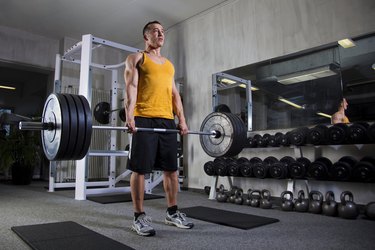
Deadlifts work your upper and lower back, hips and legs. In addition to improving posture and strengthening your muscles, deadlifts improve your strength and power. Different styles of deadlift exist, so if you have trouble with one style of deadlift, you can experiment with another style. If you have a preexisting back injury, consult your health care provider before attempting to deadlift. If you use proper form, and don't have any pre-existing back injuries, deadlifts won't damage your discs.
The Deadlift
Video of the Day
The conventional deadlift, or most common style of deadlifting, involves pulling a loaded barbell from the ground. Your feet should be no wider than your shoulders, and you should grip the bar with your hands just outside your legs. To avoid excessive strain on your lower back, bend down to grip the bar but push your hips back, keeping your shoulders behind the bar and your torso as close to vertical as possible. When standing up with the bar, continue to push your shoulders back, and avoid rounding your back at all times. The conventional deadlift strains the lower back the most, but is not directly harmful to the discs of your spine, according to a study published in the July 2000 issue of "Medicine and Science in Sports and Exercise."
Video of the Day
Sumo Deadlifts
An alternative which can reduce the shearing force on your lower back is the sumo-style deadlifts. Sumo deadlifts involve placing your feet wider than your shoulders, sometimes nearly 1.5 times the width of your shoulders. By pushing your hips down and knees out before pulling the bar from the ground, you are able to maintain a far more erect torso position. This also has the effect of reducing the work done by your lower back. According to the April 2002 issue of "Medicine and Science in Sports and Exercise," the sumo deadlift works your legs more than the conventional deadlift.
Minimizing Spinal Shear
While the deadlift may not be damaging to the discs of your spine, if you have areas of concern that involve your lower back, you should train with extreme caution at all times. To avoid extra strain, limit the shearing force, or force that is applied to your spine at an angle, as much as possible. Your spine can tolerate more force vertically than it can horizontally, which is why an erect torso position minimizes shearing force. A common mistake when deadlifting is to allow the bar to drift away from your body. By keeping the bar in closer it minimizes the strain on your lower back caused by excessive shearing force.
Effects of Long-Term Training
While there are no long-term comprehensive studies of deadlift training, a six-month study published in the "Journal of Strength and Conditioning Research" which featured regular deadlifting showed no ill effects from training. After the six-month period, all participants displayed an increase in bone mineral density, which means that not only did their muscles get stronger, so did their skeletons. While this response is usually greater in younger subjects, it will occur in lifters regardless of age.
- Medicine and Science in Sports and Exercise: A Three-dimensional Biomechanical Analysis of Sumo and Conventional Style Deadlifts
- Medicine and Science in Sports and Exercise: An Electromyographic Analysis of Sumo and Conventional Style Deadlifts
- Medicine and Science in Sports and Exercise: Lumbar Spine Loads During the Lifting of Extremely Heavy Weights
- Medicine and Science in Sports and Exercise: Biomechanical Analysis of the Deadlift During the 1999 Special Olympics World Games
- Journal of Strength and Conditioning Research: Changes in Bone Mineral Density in Response to 24 Weeks of Resistance Training in College-age Men and Women
- Scandinavian Journal of Medicine and Science in Sports: Regional Bone Mineral Density After Resistive Training in Young and Older Men and Women